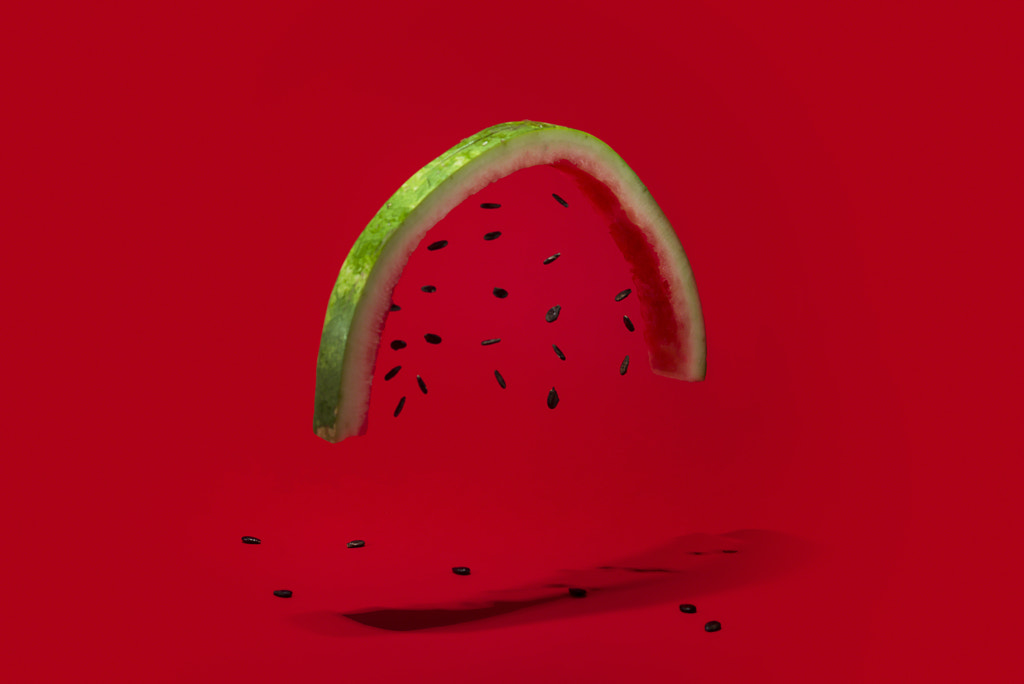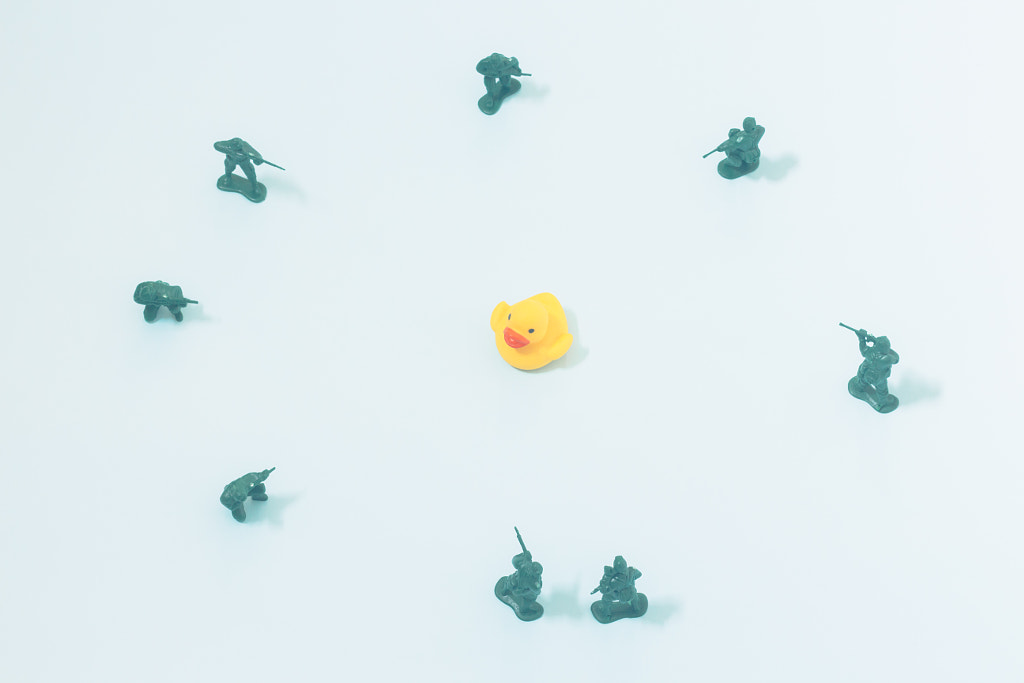Heinz once advertised their “hot ketchup” with a photo of a french fry—burned to a crisp at one end. A few years ago, the Van Gogh Museum Cafe in Amsterdam cleverly referenced the artist in an ad featuring a photo of a simple coffee cup with a broken handle.
Colgate famously ran photos of fruits without seeds as part of a dental floss campaign. More recently, the non-profit Sea Shepherd Conservation Society spread awareness about ocean pollution by publishing a series of pictures of fish turned into plastic water bottles.
These four advertisements have few things in common, but they’re all conceptual. They use simple, everyday items—from french fries to coffee mugs—to touch on larger themes, ranging from dental hygiene to marine conservation.
These kinds of conceptual images are timeless and powerful, and they’re also accessible and universally understood. Because they’re marketable to clients across different industries—and because they don’t require a large budget—conceptual still life photos are a worthwhile addition to any Licensing portfolio.
Here are our top tips for creating relatable conceptual images that sell.
Get creative
In 2018, Getty Images reported a 116% increase in searches for the term “unexpected concept.” Conceptual still lives always have that element of surprise; maybe the shapes or the colors draw you in, but it’s the visual pun that makes you look twice.
Luckily, you don’t need expensive materials or supplies to create these images—you just need a novel idea. Advertisements in magazines and websites are great places to start; look at how brands use abstract still life images to attract customers.
Another tip? Start brainstorming creative and unexpected ways to use ordinary objects. All you need is stuff you have around the house, a seamless background, and your imagination.
If you’ve read Malcolm Gladwell’s Outliers, you’ve heard of the “brick-and-blanket test.” Get out a pen and paper, and write down all the potential ways you could use a brick or a blanket. In the beginning, you’ll think of the obvious, but as you go along, you might generate totally unexpected ideas. That’s where your conceptual thinking will take over.
Stay versatile
As you get into the habit of thinking conceptually, consider ways to give your photos more than one meaning or interpretation. Hardi Saputra’s photo of a house of cards, above, would be equally at home in an advertisement about building renovation or an article about planning for the future or assessing risks.
This kind of versatility and abstract thinking can make the difference between a photo that sells just once and one that sells over and over again. The more purposes and contexts you can imagine for a single photo, the greater your potential for sales.
Make it relevant
Conceptual still lives are evergreen in the world of commercial photography—and they don’t fade as new trends come and go—but there are ways to make them especially timely. These days, brands are thinking more than ever about sustainability, wellness, equality, and technology, and all of these topics can be explored through simple tabletop still lives.
This photo above, also by Hardi Saputra, could speak to topics like security or safety on one level, but it could also convey a message about conservation and the impact of mankind’s actions on the natural world and environment.
In the age of the coronavirus, social distancing, virtual connectivity, and hand-washing have also become themes that brands and marketers want to promote and explore, and there are tons of abstract ways to express these concepts. Start with the concept itself and then start gathering the objects and props you need to execute it.
Keep it simple
Once you land on the idea, consider the easiest or simplest means by which you could illustrate it, without any distracting details. Your concept should always come first, and every element of the photo should come together to convey and emphasize that idea.
You’ll notice that all the photos in this piece—and the ads we reference—include just a few props and plenty of copy space. These images are versatile, and buyers can adapt and customize them to suit their needs; there’s room for them to crop or add a logo, and the message or theme remains the same.
Your photo should work on its own, but it should also work as a template or canvas for the buyer to use how they see it. When in doubt, take the “thumbnail test.” Would a buyer looking at just a tiny thumbnail of your image understand what’s going on and what story you’re telling? If not, take that as a cue to simplify your composition.
Make it accessible
The words “conceptual” and “accessible” don’t always go hand-in-hand, but when it comes to commercial still lives, relatability is key. If it’s difficult to explain your concept in words, it might be too vague or obscure, so spend some time formulating—and clarifying—the idea you want to express.
Conceptual photos contain layers of meaning, but they’re also straightforward. The power of this image by Marian Vejcik Slovcar lies in its directness; the juxtaposition of the car keys and glass of whiskey makes it immediately apparent that this isn’t an average product photo, but an important statement about drinking responsibly and following the law.
Conceptual still lives often explore universal themes like joy, sadness, individuality, or togetherness, so even if they are surreal and out-of-the-ordinary, they should also feel real and authentic. That means that extreme edits and filters are best avoided; let your idea speak for itself, without any unnatural effects or post-processing.
Think symbolically
Conceptual still lives often speak through iconography or symbols. Centuries ago, the Flemish painter Osias Beert used butterflies to symbolize salvation, and fruits like cherries and strawberries to represent souls in paradise. In the 17th century, still life painters frequently incorporated skulls and hourglasses to express the passage of time.
This kind of symbolism is still relevant today. In the photo above by Dina Belenko, for example, coffee becomes a symbol of energy, joy, and positivity. Ordinary objects like flowers, household items, foods, and more can stand in for larger concepts or emotions, adding another layer of meaning to your images.
Add keywords
Your conceptual still lives can’t be found unless you add conceptual keywords. Anna Koldunova, the artist behind the photo above, might include literal keywords to describe her still life scene—e.g., “pink”, “rubber”, “wood”, etc.—but she’s also tagged it with great conceptual words and phrases to describe the meaning behind the image.
Conceptual keywords like “divergent”, “leadership”, “diversity”, “loneliness”, and “individual” all point to the true symbolism behind Koldunova’s balloons, and these are all phrases commercial clients would search while looking for photos. The title and description—‘To be different’ and “The concept of a unique person among the crowd.”—also speak to the abstract ideas at work within the image.
Re-examine your archive
Chances are you probably have at least some of these conceptual still lives already, even if you don’t know it yet. Take a look at how top photographers on 500px use conceptual keywords, and think about how you could apply those same ideas to photos you’ve already shot. Beyond their literal interpretations, you could discover a fresh new way to market your work and increase its Licensing potential.
“Consider still life photos you already have in your portfolio, and try to look at them with fresh eyes,” the 500px Content Team suggests. “Imagine the different messages that could be interpreted from the photo. For example, a photo of adult rain boots next to children’s rain boots can be read as ‘saving for a rainy day.’”

Not on 500px yet? Sign up here to explore more impactful photography.
The post Best practices: Conceptual still life appeared first on 500px.
[NDN/ccn/comedia Links]










No comments:
Post a Comment